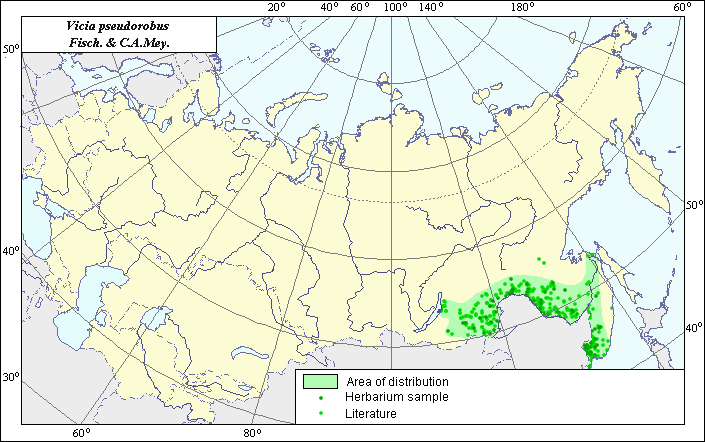Relatives
The area of Vicia pseudorobus Fisch. and C.A.Mey. (Pseudobitterpea vetch).
 Object description Download GIS-layers
Object description Download GIS-layers
Authors:
The expert-botanist - T.N. Smekalova, the GIS-expert - R.S. Ushakova.Date of creation:
03.03.2005.Scale:
1:20 000 000.Accuracy of a map:
Map is based on data from herbarium specimans and specified on maps having the following scale - 1:25 000 000 - 1:85 000 000.The projection:
"Alber's Equal Area Conic for Russia", 9, 1001, 7, 100, 0, 44, 68, 0, 0.Basic content:
Map is a vector fail consisting of polygon and points. Locations of species are represented by points, area of possible distribution of species are represented by polygon.Accuracy of the qualifier:
Lidht-colored points are locations referenced in literature sources. Dark-colored points are locations of species that were reported from herbarium samples. Polygon is based on generalized information from literature sources, herbarium specimans, political boundaries and ecological description.Method of map construction:
The basic part of species area is distribured in territory of Japan and China. In territory of the former USSR there is northern part of the area, which is distributed in Eastern Siberia and on the Far East. As a material for construction of the area the factual data from herbaria (Biological-Soil Institute of Far East Division of Russian Academy of Science; Komarov Bot.Inst.) and the data of published maps of species area (Kharkevich, 1989, Flora of the Central Siberia, 1979, Flora of the Siberia, 1994, Nikiforova, 1988) were used. The area is submitted as range and separate points. In a northwest part of the area the species reaches east coast of Baikal lake, in a southeast - reaches the coast of Japan sea. Northeast, southwest and northern borders of range are carried out by generalization of the available factual data. The southern border of range coincides with frontier of the former USSR. The points which were not included into borders of a contour, represent individual sites of species, distributed rather far from the basic range.Sources of the data:
Cherepanov, S.K. 1995. Plantae Vasculares Rossicae et Civitatum Collimitanearum (in limicis USSR olim). St-Petersburg, "Mir I Semia", 990 p. (in Russian).Flora USSR, 1948. Vol. 13. B.K., Shishkin, E.G., Bobrov (eds.) M.-L.: Publishing House of Acad. Science, p.444-445. (in Russian).
Flora of Siberia. Fabaceae (Leguminosae). 1994. Polozhij A.V., Malyshev's L.I. (ed.). vol. 9. Novosibirsk: Nauka, 280 p. (in Russian).
Flora of the Central Siberia. 1979. Malyshev's L.I., Peshkova's G.A. (ed.). vol. 2, Novosibirsk: Nauka, p. 628. (in Russian).
Nikiforova, O.D. 1988. Wild growing wetchs of Siberia. - Novosibirsk: Nauka, p. 67. (in Russian).
Herbarium Specimans - Komarov Botanical Institute (Spb, Russia), Biological-Soil Institute of Far East Branch of Russian Academy of Science (Vladivostok, Russia).
Vascular plants of the Soviet Far East. 1989. Kharkevich.s S.S. (ed.), vol. 4. Leningrad: Nauka, 380 p. (in Russian).
Right and copyright:
Copyright on this map and description belongs to its authors.Copyright for picture belongs Chuhina I.G.

